We’re No. 1! is a weekly feature looking at first issues in new comic series, as well as one-offs and special releases. In his reviews, Jeff highlights stories with diverse characters and plot lines Geekquality readers can care about, as well as points out comics that miss the mark.
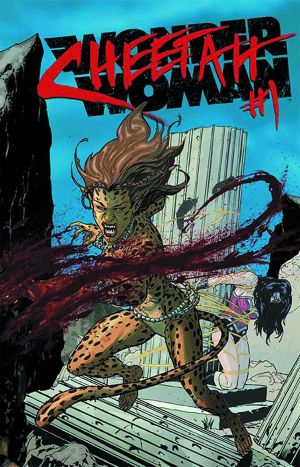 Villains month rolls on at DC comics, and two women take the stage this week. First off is the old school Wonder Woman foe in The Cheetah #1 (Wonder Woman #23.1). How old school? I first recall her as part of the Legion of Doom in the old Superfriends series, though there she had very little to do. Here, veteran writer John Ostrander (Suicide Squad, Star Wars Legacy) gives her plenty of attention, bringing us her origin story and a real time adventure set in DC’s world temporarily without heroes. Long regarded as Diana’s primary foe, Barbara Minerva has been depicted in the New 52 as a one time ally of Wonder Woman, before the mysterious God Slayer Knife turned her into the avatar of the Goddess of the Hunt. It turns out Barbara is much more a tragic figure than that: raised in a cult that worshiped Amazons in a distorted way, hunting young boys to the death in rituals of adulthood. Barbara is manipulated by her cult mother, after being abandoned by her father as a child, and her deep seated issues emerge in shocking bouts of violence. The book paints a picture (in this case expertly drawn by artist Victor Ibanez) of a woman who is certainly strong physically, but very much dark and wounded psychologically. Cheetah is less of a role-model (and frankly, were weren’t expecting that during Villains Month) than a victim, but she has so fully embraced violence and death that it’s hard to have sympathy for her.
Villains month rolls on at DC comics, and two women take the stage this week. First off is the old school Wonder Woman foe in The Cheetah #1 (Wonder Woman #23.1). How old school? I first recall her as part of the Legion of Doom in the old Superfriends series, though there she had very little to do. Here, veteran writer John Ostrander (Suicide Squad, Star Wars Legacy) gives her plenty of attention, bringing us her origin story and a real time adventure set in DC’s world temporarily without heroes. Long regarded as Diana’s primary foe, Barbara Minerva has been depicted in the New 52 as a one time ally of Wonder Woman, before the mysterious God Slayer Knife turned her into the avatar of the Goddess of the Hunt. It turns out Barbara is much more a tragic figure than that: raised in a cult that worshiped Amazons in a distorted way, hunting young boys to the death in rituals of adulthood. Barbara is manipulated by her cult mother, after being abandoned by her father as a child, and her deep seated issues emerge in shocking bouts of violence. The book paints a picture (in this case expertly drawn by artist Victor Ibanez) of a woman who is certainly strong physically, but very much dark and wounded psychologically. Cheetah is less of a role-model (and frankly, were weren’t expecting that during Villains Month) than a victim, but she has so fully embraced violence and death that it’s hard to have sympathy for her.
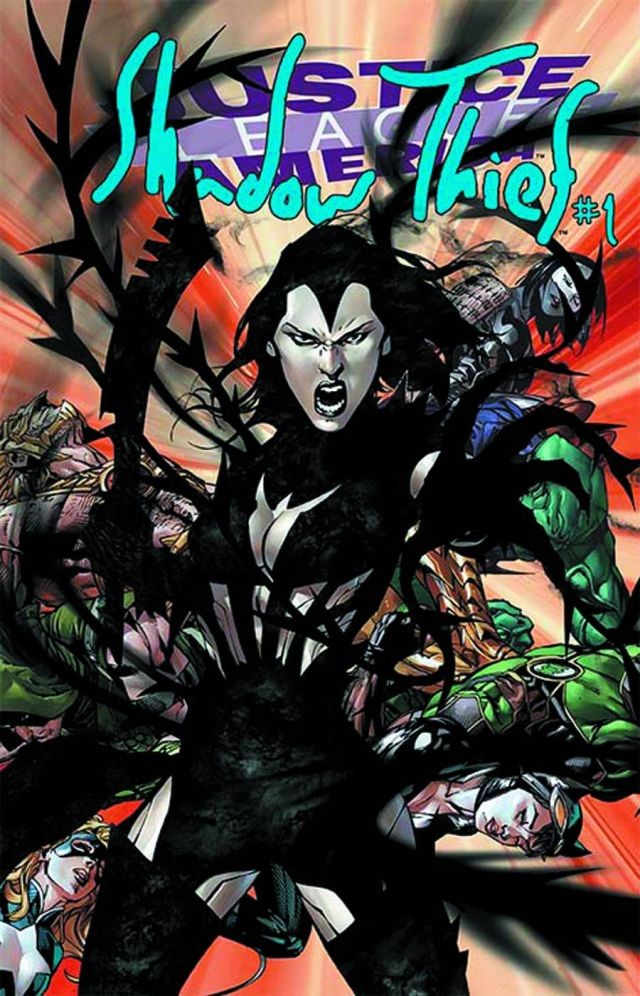 There is a surprising reboot of an old school Hawkman foe in Shadow Thief #1 (Justice League of America #7.3). Originally written as a male character, the new 52 reboot brings us a gender swapped version. Aviva is a former Mossad agent who went rogue after learning her masters were in league with alien life forms. She possesses a suit that allows her to teleport via an alien dimension through shadows here on earth. The “shadow suit” also has various shape changing abilities, is jet black, and may or may not be permanently bonding to Aviva while driving her to paranoia and xenophobia. The parallels to the symbiotic organism that attacked Spider-man and became Venom and Carnage in the Marvel Universe are so blatant one worries about copyright infringement. Beyond that, the story by legendary writer and editor Tom DeFalco is rather confusing, jumping about in flashbacks and flash forwards. Aviva is another strong willed woman set in the wrong direction by tragedy (again in this case involving the death of her family) and her victimization has more presence than Cheetah’s. She fights super heroes of alien origin because she has become terrified that they will bring destruction on the Earth. She also fears that her alien suit’s abilities will turn her into that which she fears most, but still isn’t convinced enough to stop her violent behavior. Told with first person narration, this makes her story more tragic, but makes the character less compelling, and Aviva comes off as an example of “what not to do” rather than a valuable character, sadly.
There is a surprising reboot of an old school Hawkman foe in Shadow Thief #1 (Justice League of America #7.3). Originally written as a male character, the new 52 reboot brings us a gender swapped version. Aviva is a former Mossad agent who went rogue after learning her masters were in league with alien life forms. She possesses a suit that allows her to teleport via an alien dimension through shadows here on earth. The “shadow suit” also has various shape changing abilities, is jet black, and may or may not be permanently bonding to Aviva while driving her to paranoia and xenophobia. The parallels to the symbiotic organism that attacked Spider-man and became Venom and Carnage in the Marvel Universe are so blatant one worries about copyright infringement. Beyond that, the story by legendary writer and editor Tom DeFalco is rather confusing, jumping about in flashbacks and flash forwards. Aviva is another strong willed woman set in the wrong direction by tragedy (again in this case involving the death of her family) and her victimization has more presence than Cheetah’s. She fights super heroes of alien origin because she has become terrified that they will bring destruction on the Earth. She also fears that her alien suit’s abilities will turn her into that which she fears most, but still isn’t convinced enough to stop her violent behavior. Told with first person narration, this makes her story more tragic, but makes the character less compelling, and Aviva comes off as an example of “what not to do” rather than a valuable character, sadly.
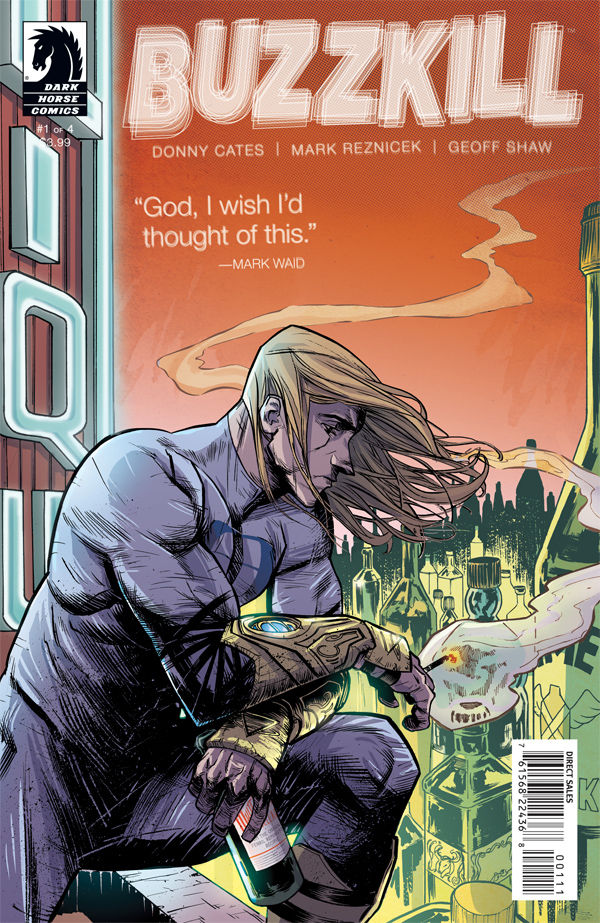 Thankfully there were some other solid releases this week, as Villains Month is becoming tiresome. The best of the bunch is Buzzkill #1 from Dark Horse, written by Donny Cates and Mark Reznicek (who is also the drummer for the band The Toadies). The story tackles addiction, an issue not seen often in comics. Ruben is an alcoholic taking his first steps towards sobriety, seeking out an AA group where he feels he can open up. Ruben’s secrets go deeper than most addicts, however, as he’s also a super hero whose incredible strength comes from ingesting huge amounts of alcohol and drugs. By getting sober, he’s giving up his gifts and his crime-fighting career, and the city’s super villains are helping push him in that direction. The book is complex and well illustrated by Geoff Shaw, in a sort of gritty way that works with the story. It’s a brain twister for sure, and as I read it I was equal parts fascinated and appalled. Many friends and families of addicts experience conflicting emotions, as they struggle to feel sympathy for their recovering loved ones, while also feeling anger or disgust over their behavior. The writers effectively create that juxtaposition of feeling toward Ruben as part of telling the story, which is something worth commending. It’s also odd to think that, as the story continues, I may actually root for Ruben to fall off the wagon, as he’ll probably need to be a super hero at some point in the book. That conflict makes for a fine book worth picking up.
Thankfully there were some other solid releases this week, as Villains Month is becoming tiresome. The best of the bunch is Buzzkill #1 from Dark Horse, written by Donny Cates and Mark Reznicek (who is also the drummer for the band The Toadies). The story tackles addiction, an issue not seen often in comics. Ruben is an alcoholic taking his first steps towards sobriety, seeking out an AA group where he feels he can open up. Ruben’s secrets go deeper than most addicts, however, as he’s also a super hero whose incredible strength comes from ingesting huge amounts of alcohol and drugs. By getting sober, he’s giving up his gifts and his crime-fighting career, and the city’s super villains are helping push him in that direction. The book is complex and well illustrated by Geoff Shaw, in a sort of gritty way that works with the story. It’s a brain twister for sure, and as I read it I was equal parts fascinated and appalled. Many friends and families of addicts experience conflicting emotions, as they struggle to feel sympathy for their recovering loved ones, while also feeling anger or disgust over their behavior. The writers effectively create that juxtaposition of feeling toward Ruben as part of telling the story, which is something worth commending. It’s also odd to think that, as the story continues, I may actually root for Ruben to fall off the wagon, as he’ll probably need to be a super hero at some point in the book. That conflict makes for a fine book worth picking up.
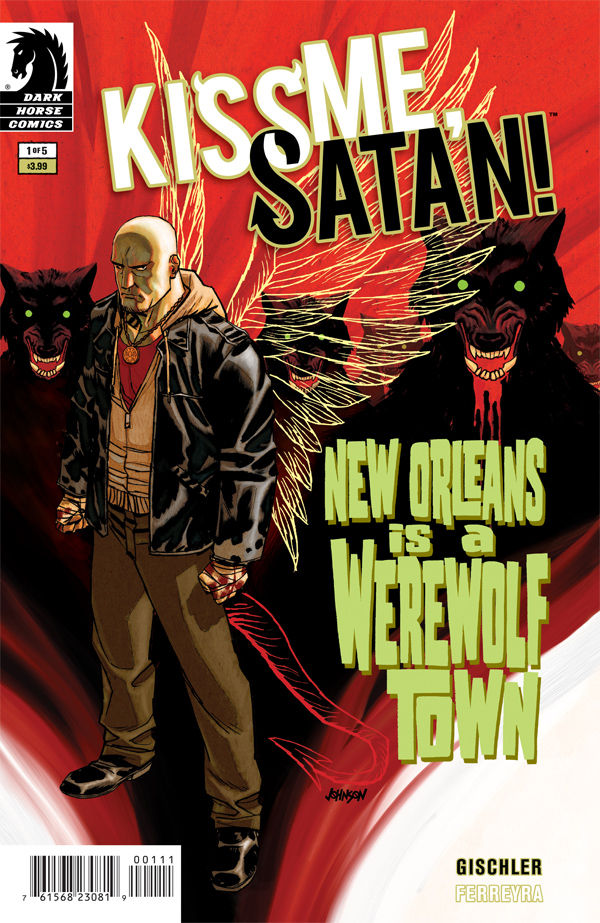 There’s little emotional complexity in Kiss Me Satan #1, but that doesn’t meant there’s not a lot going on. KMS is the story of Barnabus Black, the only fallen angel to request pardon from Heaven. He’s now been made the Lord’s assassin, apparently, doing the dirty work that God can’t be bothered with on Earth, and he’s gotten himself embroiled in a New Orleans werewolf war of Shakespearean proportions. After a witch realizes that the local pack leader’s son won’t be born a lycanthrope, she and her apprentices (of whom there are predictable three) have to make a break for it. The wolves can’t let this embarrassing secret get out after all, and Barnabas ends up the witches’ protector. It was disappointing not to see the witches get to protect themselves, the implication being they wouldn’t be capable of it independently. While it’s a rip-roaring adventure comic with all sorts of high stakes action, the women in the book aren’t treated with much respect.
There’s little emotional complexity in Kiss Me Satan #1, but that doesn’t meant there’s not a lot going on. KMS is the story of Barnabus Black, the only fallen angel to request pardon from Heaven. He’s now been made the Lord’s assassin, apparently, doing the dirty work that God can’t be bothered with on Earth, and he’s gotten himself embroiled in a New Orleans werewolf war of Shakespearean proportions. After a witch realizes that the local pack leader’s son won’t be born a lycanthrope, she and her apprentices (of whom there are predictable three) have to make a break for it. The wolves can’t let this embarrassing secret get out after all, and Barnabas ends up the witches’ protector. It was disappointing not to see the witches get to protect themselves, the implication being they wouldn’t be capable of it independently. While it’s a rip-roaring adventure comic with all sorts of high stakes action, the women in the book aren’t treated with much respect.
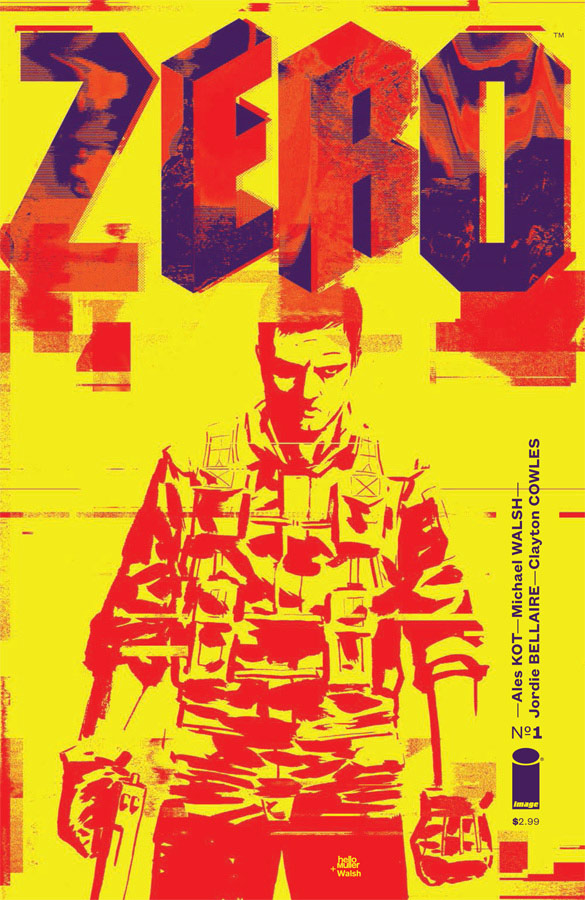 Lastly we have the complex spy comic Zero #1 by writer Ales Kot (Changes, Wild Children) with art by Michael Walsh (Comeback, The X-Files). (Full disclosure: Ales Kot and I are personally acquainted.) Zero is the story of Edward Zero, a hard hitting spy and assassin on the trail of some advanced technology. The tech is hardwired into a Palestinian terrorist engaged in an earth shattering battle with a similarly equipped Israeli soldier. The ages old conflict takes a futuristic turn with incredible levels of violence, and violence is Edward Zero’s stock in trade. The tale isn’t necessarily about the conflict, but seems to revolve around the nature of violent action in general. Zero tells the tale in flashback to a 10 year old boy who holds a pistol to his head, apparently sent to kill the aging spy. Violence permeates every part of Zero’s life, as he tells us he was raised to kill from a young age as well. Even his “handlers” back home, known only as “Zizek” and “Cooke” are awash in psychological violence, arguing over Zero’s methods and trying to resolve the sexual tension between them in dramatic ways. There’s hardly a panel in the book that doesn’t exude lethal force, and Walsh’s crisp, distinct style makes the blood and death that much more visceral. The ongoing story will likely continue exploring questions of morality, particularly lack thereof and how humans can come to such depths.
Lastly we have the complex spy comic Zero #1 by writer Ales Kot (Changes, Wild Children) with art by Michael Walsh (Comeback, The X-Files). (Full disclosure: Ales Kot and I are personally acquainted.) Zero is the story of Edward Zero, a hard hitting spy and assassin on the trail of some advanced technology. The tech is hardwired into a Palestinian terrorist engaged in an earth shattering battle with a similarly equipped Israeli soldier. The ages old conflict takes a futuristic turn with incredible levels of violence, and violence is Edward Zero’s stock in trade. The tale isn’t necessarily about the conflict, but seems to revolve around the nature of violent action in general. Zero tells the tale in flashback to a 10 year old boy who holds a pistol to his head, apparently sent to kill the aging spy. Violence permeates every part of Zero’s life, as he tells us he was raised to kill from a young age as well. Even his “handlers” back home, known only as “Zizek” and “Cooke” are awash in psychological violence, arguing over Zero’s methods and trying to resolve the sexual tension between them in dramatic ways. There’s hardly a panel in the book that doesn’t exude lethal force, and Walsh’s crisp, distinct style makes the blood and death that much more visceral. The ongoing story will likely continue exploring questions of morality, particularly lack thereof and how humans can come to such depths.

